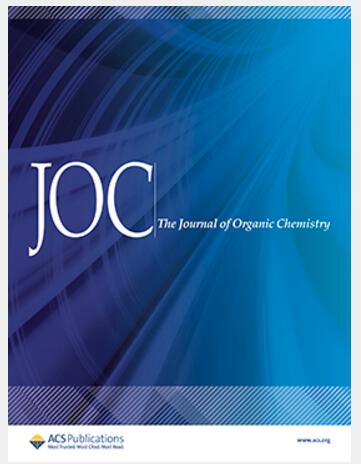为什么在乙烯烯与CO的碳环化过程中Rh倾向于[4 + 1]而Pd倾向于[4 + 4 + 1]模式?揭示镍的潜力,以扩大范围超越钯
IF 3.3
2区 化学
Q1 CHEMISTRY, ORGANIC
引用次数: 0
摘要
铑(I)促进了乙烯烯底物和CO的[4 + 1]组装模式,导致形成五元环结构。与之形成鲜明对比的是,钯(0)催化更复杂的[4 + 4 + 1]模式生成九元环酮。即使在今天,控制这种组装模式对比的潜在机制仍然不清楚,这对进一步发展有效的反应提出了重大挑战。我们的计算研究表明,Rh采用与CO的方形锥体几何形状。这与Pd相反,Pd倾向于三角形平面几何形状。在Rh中检测到比在Pd中间体中更强的金属- co相互作用,使得[4 + 1]模式在Rh中比在Pd中更有利。在Rh的情况下,两个乙烯烯之间的C-C偶联的过渡态具有明显扭曲的四面体核,而Pd保持稳定的三角平面结构,使得[4 + 4 + 1]反应在Rh中不如在Pd中有利。通过将Pd的关键特性概念化并转移到Ni体系中,我们合理地设计了一种Ni催化的[4 + 4 + 1]版本,它结合了Pd的理想反应性与Ni的成本效益和丰度,符合合成有机化学中对更可持续和原子效率策略日益增长的需求。本文章由计算机程序翻译,如有差异,请以英文原文为准。
![Why Does Rh Prefer [4 + 1] while Pd Prefer [4 + 4 + 1] Mode in Carbocyclization of Vinylallene with CO? Unveiling Nickel’s Potential for Expanding the Scope Beyond Pd](https://img.booksci.cn/booksciimg/2025-5/2025051510447742405217.png)
Why Does Rh Prefer [4 + 1] while Pd Prefer [4 + 4 + 1] Mode in Carbocyclization of Vinylallene with CO? Unveiling Nickel’s Potential for Expanding the Scope Beyond Pd
Rhodium(I) promotes a [4 + 1] assembly mode with a vinylallene substrate and CO, leading to the formation of a five-membered ring structure. In striking contrast, palladium(0) catalyzes a more complex [4 + 4 + 1] mode leading to a nine-membered cyclic ketone. The underlying mechanisms that govern this contrast in assembly modes remain unclear, even in today’s date, presenting a major challenge to the further development of efficient reactions. Our computational study reveals that Rh adopts a square pyramidal geometry with CO. This is in contrast to Pd, which prefers a trigonal planar geometry. A stronger metal–CO interaction is detected in Rh than in a Pd intermediate, making the [4 + 1] mode more preferable in Rh than in Pd. The transition state for C–C coupling between two vinylallene has a significantly distorted tetrahedral core in the case of Rh, while Pd retains a stable trigonal planar structure, making the [4 + 4 + 1] reaction less favorable in Rh than in Pd. By conceptualizing and transferring the critical features of Pd to Ni systems, we have rationally designed a Ni-catalyzed [4 + 4 + 1] version that combines the desirable reactivity of Pd with the cost-effectiveness and abundance of Ni, aligning with the growing demand for more sustainable and atom-efficient strategies in synthetic organic chemistry.
求助全文
通过发布文献求助,成功后即可免费获取论文全文。
去求助
来源期刊

Journal of Organic Chemistry
化学-有机化学
CiteScore
6.20
自引率
11.10%
发文量
1467
审稿时长
2 months
期刊介绍:
Journal of Organic Chemistry welcomes original contributions of fundamental research in all branches of the theory and practice of organic chemistry. In selecting manuscripts for publication, the editors place emphasis on the quality and novelty of the work, as well as the breadth of interest to the organic chemistry community.
 求助内容:
求助内容: 应助结果提醒方式:
应助结果提醒方式:


